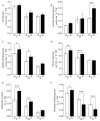Mechanism of [CO2] Enrichment Alleviated Drought Stress in the Roots of Cucumber Seedlings Revealed via Proteomic and Biochemical Analysis
- PMID: 36499239
- PMCID: PMC9737773
- DOI: 10.3390/ijms232314911
Mechanism of [CO2] Enrichment Alleviated Drought Stress in the Roots of Cucumber Seedlings Revealed via Proteomic and Biochemical Analysis
Abstract
Cucumber is one of the most widely cultivated greenhouse vegetables, and its quality and yield are threatened by drought stress. Studies have shown that carbon dioxide concentration ([CO2]) enrichment can alleviate drought stress in cucumber seedlings; however the mechanism of this [CO2] enrichment effect on root drought stress is not clear. In this study, the effects of different drought stresses (simulated with 0, 5% and 10% PEG 6000, i.e., no, moderate, and severe drought stress) and [CO2] (400 μmol·mol-1 and 800 ± 40 μmol·mol-1) on the cucumber seedling root proteome were analyzed using the tandem mass tag (TMT) quantitative proteomics method. The results showed that after [CO2] enrichment, 346 differentially accumulating proteins (DAPs) were found only under moderate drought stress, 27 DAPs only under severe drought stress, and 34 DAPs under both moderate and severe drought stress. [CO2] enrichment promoted energy metabolism, amino acid metabolism, and secondary metabolism, induced the expression of proteins related to root cell wall and cytoskeleton metabolism, effectively maintained the balance of protein processing and degradation, and enhanced the cell wall regulation ability. However, the extent to which [CO2] enrichment alleviated drought stress in cucumber seedling roots was limited under severe drought stress, which may be due to excessive damage to the seedlings.
Keywords: CO2 enrichment; TMT-based quantitative proteomic; amino acid metabolism; carbohydrate synthesis; cucumber roots; drought stress.
Conflict of interest statement
The authors declare no conflict of interest.
Figures









Similar articles
-
Physiological and iTRAQ based proteomics analyses reveal the mechanism of elevated CO2 concentration alleviating drought stress in cucumber (Cucumis sativus L.) seedlings.Plant Physiol Biochem. 2019 Oct;143:142-153. doi: 10.1016/j.plaphy.2019.08.025. Epub 2019 Aug 29. Plant Physiol Biochem. 2019. PMID: 31493674
-
[Responses of non-structural carbohydrate metabolism of cucumber seedlings to drought stress and doubled CO2 concentration].Ying Yong Sheng Tai Xue Bao. 2015 Jan;26(1):53-60. Ying Yong Sheng Tai Xue Bao. 2015. PMID: 25985653 Chinese.
-
Metabolomics analysis reveals that elevated atmospheric CO2 alleviates drought stress in cucumber seedling leaves.Anal Biochem. 2018 Oct 15;559:71-85. doi: 10.1016/j.ab.2018.08.020. Epub 2018 Aug 25. Anal Biochem. 2018. PMID: 30149025
-
Physiological and Differential Proteomic Analyses of Imitation Drought Stress Response in Sorghum bicolor Root at the Seedling Stage.Int J Mol Sci. 2020 Dec 1;21(23):9174. doi: 10.3390/ijms21239174. Int J Mol Sci. 2020. PMID: 33271965 Free PMC article.
-
CO2 enrichment enhanced drought resistance by regulating growth, hydraulic conductivity and phytohormone contents in the root of cucumber seedlings.Plant Physiol Biochem. 2020 Jul;152:62-71. doi: 10.1016/j.plaphy.2020.04.037. Epub 2020 May 1. Plant Physiol Biochem. 2020. PMID: 32388421
References
-
- Van der Kooi C.J., Reich M., Low M., De Kok L.J., Tausz M. Growth and yield stimulation under elevated CO2 and drought: A meta-analysis on crops. Environ. Exp. Bot. 2016;122:150–157. doi: 10.1016/j.envexpbot.2015.10.004. - DOI
-
- Arndal M.F., Tolver A., Larsen K.S., Beier C., Schmidt I.K. Fine root growth and vertical distribution in response to elevated CO2, warming and drought in a mixed heathland–grassland. Ecosystems. 2018;21:15–30. doi: 10.1007/s10021-017-0131-2. - DOI
MeSH terms
Substances
Grants and funding
LinkOut - more resources
Full Text Sources

